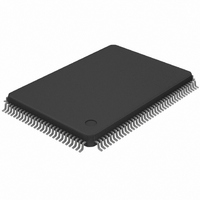DS21Q42T Maxim Integrated Products, DS21Q42T Datasheet - Page 52

DS21Q42T
Manufacturer Part Number
DS21Q42T
Description
IC FRAMER ENHANCED T1 4X 128TQFP
Manufacturer
Maxim Integrated Products
Datasheet
1.DS21Q42T.pdf
(116 pages)
Specifications of DS21Q42T
Controller Type
T1 Framer
Interface
Parallel/Serial
Voltage - Supply
2.97 V ~ 3.63 V
Current - Supply
75mA
Operating Temperature
0°C ~ 70°C
Mounting Type
Surface Mount
Package / Case
128-TQFP, 128-VQFP
Lead Free Status / RoHS Status
Contains lead / RoHS non-compliant
Available stocks
Company
Part Number
Manufacturer
Quantity
Price
Part Number:
DS21Q42T
Manufacturer:
DALLAS
Quantity:
20 000
TS1 TO TS12: TRANSMIT SIGNALING REGISTERS (Address=70 to 7B Hex)
(MSB)
A(8)
A(16)
A(24)
B(8)
B(16)
B(24)
A/C(8)
A/C(16) A/C(15) A/C(14) A/C(13) A/C(12) A/C(11) A/C(10) A/C(9)
A/C(24) A/C(23) A/C(22) A/C(21) A/C(20) A/C(19) A/C(18) A/C(17) TS9 (78)
B/D(8)
B/D(16) B/D(15) B/D(14) B/D(13) B/D(12) B/D(11) B/D(10) B/D(9)
B/D(24) B/D(23) B/D(22) B/D(21) B/D(20) B/D(19) B/D(18) B/D(17) TS12 (7B)
Each Transmit Signaling Register (TS1 to TS12) contains the Robbed Bit signaling for eight DS0
channels that will be inserted into the outgoing stream if enabled to do so via TCR1.4. In the ESF
framing mode, there can be up to four signaling bits per channel (A, B, C, and D). On multiframe
boundaries, the framer will load the values present in the Transmit Signaling Register into an outgoing
signaling shift register that is internal to the device. The user can utilize the Transmit Multiframe
Interrupt in Status Register 2 (SR2.6) to know when to update the signaling bits. In the ESF framing
mode, the interrupt will come every 3 ms and the user has a full 3ms to update the TSRs. In the D4
framing mode, there are only two signaling bits per channel (A and B). However in the D4 framing
mode, the framer uses the C and D bit positions as the A and B bit positions for the next multiframe. The
framer will load the values in the TSRs into the outgoing shift register every other D4 multiframe.
10.2 Hardware-Based Signaling
Receive Side
In the receive side of the hardware based signaling, there are two operating modes for the signaling
buffer; signaling extraction and signaling re–insertion. Signaling extraction involves pulling the signaling
bits from the receive data stream and buffering them over a four multiframe buffer and outputting them in
a serial PCM fashion on a channel–by–channel basis at the RSIG output. This mode is always enabled.
In this mode, the receive elastic store may be enabled or disabled. If the receive elastic store is enabled,
then the backplane clock (RSYSCLK) can be either 1.544 MHz or 2.048 MHz. In the ESF framing
mode, the ABCD signaling bits are output on RSIG in the lower nibble of each channel. The RSIG data
is updated once a multiframe (3 ms) unless a freeze is in effect. In the D4 framing mode, the AB
signaling bits are output twice on RSIG in the lower nibble of each channel. Hence, bits 5 and 6 contain
the same data as bits 7 and 8 respectively in each channel. The RSIG data is updated once a multiframe
(1.5 ms) unless a freeze is in effect. See the timing diagrams in Section 20 for some examples.
SYMBOL
D(24)
A(1)
A(7)
A(15)
A(23)
B(7)
B(15)
B(23)
A/C(7)
B/D(7)
A(6)
A(14)
A(22)
B(6)
B(14)
B(22)
A/C(6)
B/D(6)
POSITION
TS12.7
TS1.0
A(5)
A(13)
A(21)
B(5)
B(13)
B(21)
A/C(5)
B/D(5)
NAME AND DESCRIPTION
Signaling Bit D in Channel 24
Signaling Bit A in Channel 1
A(4)
A(12)
A(20)
B(4)
B(12)
B(20)
A/C(4)
B/D(4)
52 of 116
A(3)
A(11)
A(19)
B(3)
B(11)
B(19)
A/C(3)
B/D(3)
B(2)
B(10)
B(18)
A/C(2)
A(2)
A(10)
A(18)
B/D(2)
LSB)
A(1)
A(9)
A(17)
B(1)
B(9)
B(17)
A/C(1)
B/D(1)
TS1 (70)
TS2 (71)
TS3 (72)
TS4 (73)
TS5 (74)
TS7 (75)
TS7 (76)
TS8 (77)
TS10 (79)
TS11 (7A)












